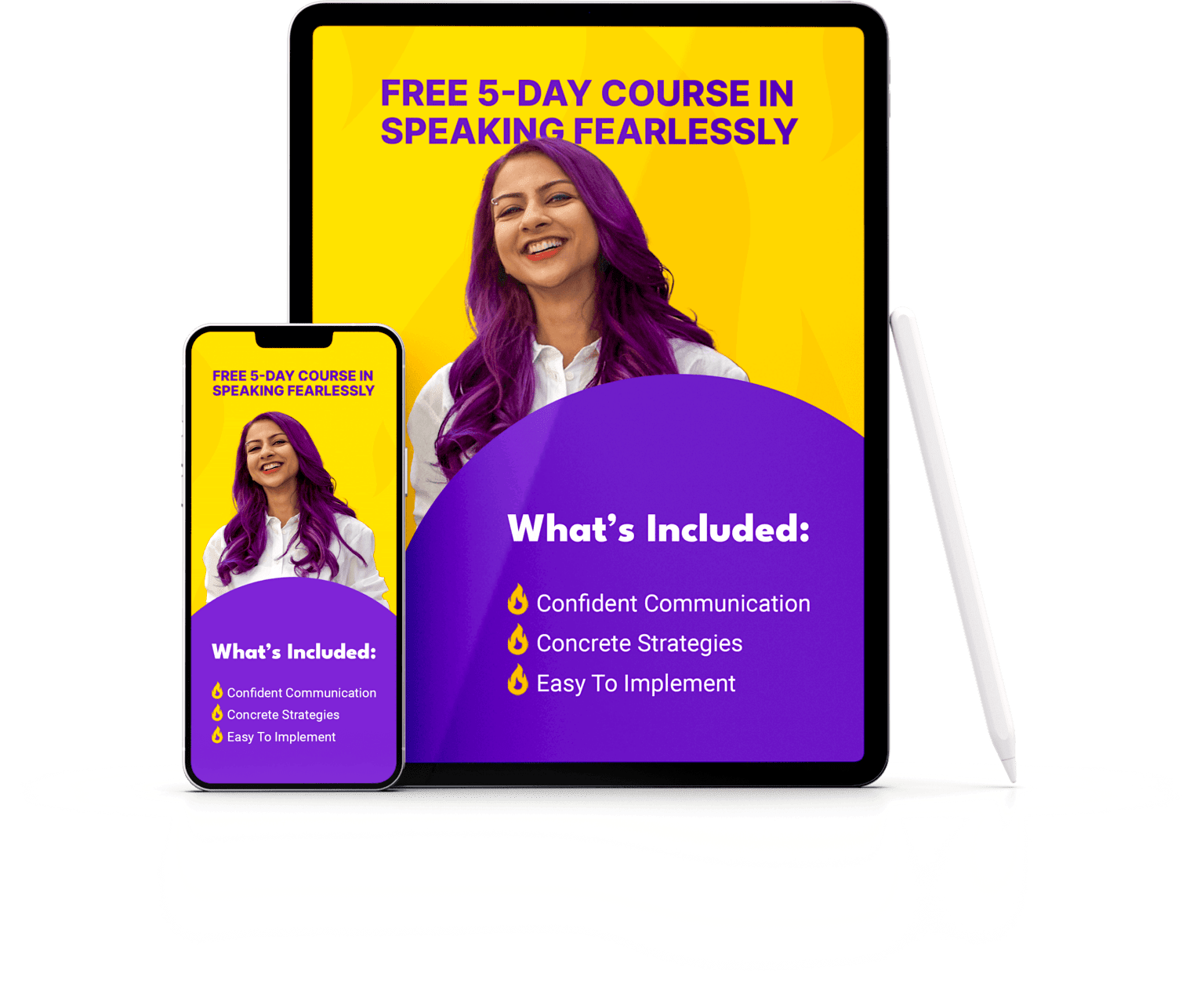The #1 question I get asked by clients is this: “Nausheen, how do I articulate my thoughts on the spot without rambling or sounding incoherent?”
Surprisingly, a lot of subject matter experts struggle with articulating their thoughts in a concise, clear, and impactful way. They often use too many words, take too long to get to the point, or use jargon that doesn’t make sense to the audience.
One client even gave a name to this phenomenon: he claimed that his “mind-to-mouth connection” malfunctioned each time he wanted to speak up in a meeting!
The reality is, you can’t always memorize a script. But you shouldn’t let that scare you away from public speaking opportunities. Whether you’re doing Q&A after a presentation, speaking in a podcast interview, or responding to a client’s unexpected objections, I’ll give you the tools you need to articulate your thoughts on the fly. With my help, you’ll continue to build your authority instead of diminishing it!
Here’s a little secret: even the best speakers aren’t born able to articulate their thoughts off the cuff. It’s a skill that can be learned through practice and coaching.
Table of Contents
1. Start with the right mindset to better articulate your thoughts

Before we dive into the nitty-gritty, let’s conquer some obstacles you may be facing with your mindset.
A. Commit and deliver – Thinking on the fly
Problem: You’ve been asked a question but you keep stumbling over your words, interrupting yourself, and changing direction on what you want to say. Or you can’t even collect your thoughts because they’re racing too much to grab hold of them.
Solution: Commit and deliver.
You’re most likely to face a block while you’re talking because you’re second-guessing your thoughts. You may even be editing yourself before you start talking!

To combat this, see your sentences through. If you start a sentence, keep going. This will prevent you from experiencing false starts or having a blank moment.
I like to look at it this way: when you’re thinking of what to say, you’re the scriptwriter. But once you start speaking, you become the actor. Imagine how disruptive it would be if the scriptwriter kept interrupting the actor every few minutes to change the script! Don’t do that – see the sentence all the way through to become a clear communicator.
And what if your mind does go blank? Here is a strategy to combat that.
B. Pauses
Pauses are not nice to have – they are a must-have. To continue the analogy of the scriptwriter and the actor, a pause is the “passing of the script” between the two. In other words, pauses give you and the audience time to think. They show that you’re confident, not simply filling the space with words. They give you space to check in with your audience. There is power in the pause!

Photo by Brett Jordan
Here are some pauses you could use on the fly:
- Functional pauses. These pauses go where you’d expect them to: at the end of a sentence or after a comma.
- Reframe pauses. Reframe pauses are great when you run into a challenging question. Reaffirm the statement and then reframe it in a positive light.
- Reflective pauses. These pauses give you time to reflect on what was last said by the person who’s interviewing or speaking with you.
- Echo pauses. This pause is a “mic drop” you can use as your very last statement to echo in the ears of whoever is listening. Make it count!
- Provocative pause. This is a pause you can use right before sharing something significant – this helps build momentum and curiosity with the audience and gives you time to frame your thoughts.
Pauses are vital to help you think through what you’re going to say. Welcome pauses… they will help you articulate your thoughts much more impactfully.
C. Be Open and Prepared
“What do you mean, prepare? You just said I couldn’t prepare if I’m talking on the fly!”
I know, I know. You can’t memorize a script, but you can shift your mindset toward problem-solving instead of fear. If you stay open and solution-oriented even when asked tough questions, you’ll keep the upper hand.

If you get a tough question (or don’t understand the question), you’ve got a few options:
- Anticipate tough questions. Write possible questions/objections beforehand and prepare your answers.
- Pivot where you can. The question you get is not the question you need to respond to. Use a “block and bridge” strategy to respond to a question you do want to answer. For example – if your client asks if you can negotiate your hourly rate, you can pivot and talk about how they don’t get “hourly” services but completed projects.
- Postpone the response. “I’d be happy to discuss this after,” can be a game-changer. (But do figure out a way to follow up so that you remain true to your word).
2. Use thought structures to organize your thoughts
You want to articulate your thoughts in a well-organized way – even when you haven’t had time to organize them. Thought structures are a great way to do this – they give you a framework that you can follow in the moment to express yourself. Here are three common thought structures for you to try out.
A. What – So what – What now

This thought structure lets you guide your audience through the key points of your message. It works like this:
- What: Start with the key message you want the audience to focus on.
- So what: Next, share the importance or relevance of the key message for the audience.
- What now: Finally, share a specific call to action for the audience or the next steps that you’ll take.
Example #1:
You’re asked about giving an update on a project. This is how you’d follow the “What – So what – What now” structure:
What: The project is on track but we have some obstacles.
So what: We’ll be able to deliver this project on time which means we’ll hit our revenue forecast.
What now: I’ll work with the team on addressing the obstacles and we’ll have an update for you on this by next week.
Example #2:
Imagine that you’re concluding a presentation on AI:
What: So to sum up, businesses that don’t embrace AI will become obsolete.
So what: 35% of businesses worldwide have adopted AI, and 9 out of 10 say that it gives them a competitive advantage.
What now: Thanks so much for your time and you can connect with me on this email for more information on how we can work together.
B. Rule of three

Image by Pexels from Pixabay
There’s power in threes: research has proven that people understand concepts, situations, and ideas better in groups of three. You can use the rule of three when you’re articulating your thoughts to help keep you on track. Here’s how the rule of three works:
- Pick a topic.
- Come up with three points to support it.
- List a point, elaborate on it, and then move on to the next point.
Putting things in groups of three helps you be concise while providing space for you to break out the topic a little more.
Pro tip: When you come up with two things to say, your brain will help out by coming up with the third. Try it.
Example: I love peanut butter and jelly sandwiches for three reasons. One -peanut butter is savory and salty. Two – jelly is sweet and offsets the stickiness of the peanut butter. Three – hearty bread brings it all together in a symphony of tastiness.
A more serious example: Speaking in public is critical for your professional development for three reasons: first, it helps you reach a wider audience with your personal brand. Second – it builds your confidence when you’re able to express yourself in front of an audience. And third – it can help connect you with potential clients, collaborators, and partners.
C. Takeaway sandwich

Speaking of sandwiches, let’s find one more way to work in threes. A takeaway sandwich is helpful when you need to share a key message with your audience. Here’s how to do it:
- Start with a key takeaway: what do you want people to walk away with?
- Find three points to support the takeaway.
- End by restating the takeaway – but rephrasing it so it doesn’t sound like repetition.
Starting with the key takeaway forces you to be clear on this at the outset (a lot of people start speaking first and then realize what the key point was that they wanted to make). Strategic repetition is powerful – people tend to remember the beginning and the end of a list. By putting your main point at the start and end of what you’re saying, you’ll solidify it in the minds of your audience.
Example:
Imagine that you’re asked about how you help small businesses. You can use a takeaway sandwich:
Key takeaway: We work with small businesses to help them figure out their workflows and maximize revenue.
Three points to support: First, we analyze what they’re doing now that’s blocking their results. Then, we work on realigning their workflows to proven frameworks. Finally, we analyze and iterate what works and trim what doesn’t.
Complete the takeaway sandwich: So once businesses work with us, they never have to worry about messy workflows or missed revenue targets.
3. Using open improvisation to organize your thoughts
A lot of people confuse “improvisation” with “winging it”. The two are NOT the same.

“Winging it” means going in without a game plan and just blurting out whatever thoughts come to your mind. Improvisation is the art of creating on the fly – but using well-proven frameworks and rules that help you be as creative as possible in the moment.
Great improvisation is “making things up as you go along,” but doing it so well that it almost seems scripted. (Whose Line is It, Anyway? is a great example of improvisational masters at work.)
Since I performed improv comedy on stage for ten years, I wanted to share with you some key improvisation techniques that allow you to express your thoughts without feeling blocked.
You can try these techniques in your next meeting to sound more articulate, concise, and impactful.
A. “Yes, and…”
The first rule of improv is to continue building on the story as it’s told. This is referred to as the “Yes, and…” technique. It keeps performers from undermining what their improvisation partner has said and keeps the momentum going.
While you’re speaking, envision yourself saying “Yes, and…” to your interviewer (or to yourself) to keep building on what was already said. This helps you go into more detail and expand upon a topic. This helps you build confidence in the moment and shape ideas from others that have already been expressed.

Photo by Dan Burton on Unsplash
Imagine each part of the story like a building block, then build it together.
Example:
You’re on a podcast and your host says, “I didn’t realize how much I said ‘like’ until I recorded myself speaking.”
You say, “Yes, and there are so many other filler words we use. ‘Um,’ ‘uh,’ and ‘erm’ can all be removed from your presentations to make you a more effective speaker.”
Pro tip: You can use this with or without using the words “Yes, and” – just work on how to take the idea that’s already been expressed to the next level by adding on your expertise or point of view.
B. “If this is true, what else is true?”
When you need to create a narrative or tell a story, you have to not just agree with what’s been said but also go to the next step in the story. “If this is true, what else is true?” helps you articulate related thoughts to an idea that’s worth exploring. It’s like brainstorming with yourself.
This is a step beyond “Yes, and” because it lets you go further with your knowledge and flesh it out instead of staying on the same track.
Example:
You’re explaining the difference between inbound and outbound marketing.
1st idea: “Inbound marketing is all about attracting your audience instead of placing ads or cold calling”.
Now you can explore: If “attracting” your audience is true, then what else is true:
- When people are attracted to you, they find you charming.
- They might become obsessed with you.
- They might tell their friends about you.
So you can build on any of those thoughts to go to the next step and raise the stakes. For example:
“Inbound marketing creates super fans instead of just clients”.
C. Relying on your “team” partner

The biggest difference between improv comedy and standup is that in improv, you have to work with your team. It’s not a solo sport. Your presentation or podcast shouldn’t be, either.
When we’re put on the spot, we often forget that we’re not just on our own. The audience is there to fill in the gaps, to help us out, to build upon our ideas. But if we ignore the audience as a critical team member, we’re trying to improvise with ourselves.
Use the audience’s intelligence, interest, and responses to your advantage when you’re articulating your thoughts so you don’t feel the pressure of having to do all the work by yourself.
Need an extra moment to think? Pause and let the audience’s patience help you out by giving you the time to articulate your next thought. Want to get some input on an idea? Feel free to say, “Let me ask you this – I’m curious to know how you feel about XX”.
You can best articulate your ideas in a space where they’re well received and understood – so let the audience show you their understanding of your ideas as you go along. You don’t need to do all the work by yourself.
Want to level up your public speaking skills?
Collecting your thoughts off the cuff takes time, and practice doesn’t always make perfect. You need someone in your corner who can help create a positive feedback loop for you: analyzing what you do and helping you to improve. That’s what I do!
If your goal is to level up your public speaking skills in 2024 – even when you’re faced with unexpected questions – let’s talk!



